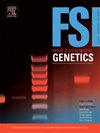在Y-STR参考数据库中发现微量供体及其父系亲属的概率
IF 3.1
2区 医学
Q2 GENETICS & HEREDITY
引用次数: 0
摘要
利用y染色体短串联重复序列(Y-STR) DNA图谱进行法医调查遗传谱系分析,可以通过在相关的Y-STR数据库中搜索Y-STR痕迹图谱或相似但不相同的Y-STR图谱,为刑事案件的调查提供线索。我们使用YfilerTM Plus和PowerPlex®Y23 Y-STR剖面进行了模拟研究,以估计在Y-STR数据库中找到匹配和接近匹配的概率。对寻找微量供体及其近亲属的成功率进行了量化。我们使用malan R软件包基于Wright-Fisher模型模拟种群,其中YHRD Y-STR突变率以贝叶斯方式纳入不确定性,繁殖成功率方差为0.2,100代恒定大小,150代增长2%。Y-STR数据库分别从YfilerTM Plus和PowerPlex®Y23 Y-STR种群数据集中随机抽取Y-STR图谱生成。在500,066个个体的种群中,数据库大小为种群的0.5%,YfilerTM Plus和PowerPlex®Y23的Y-STR数据库匹配概率分别为约6%和10%。将数据库大小增加到种群的5%,YfilerTM Plus和PowerPlex®Y23的Y-STR匹配概率分别为约41%和54%。当在数据库中发现Y-STR匹配时,YfilerTM Plus和PowerPlex®Y23中具有匹配基因的个体与追踪供者在5倍染色体内相关的概率分别为约64%和56%,包括Y-STR基因来源于供者的情况。在这种情况下,在匹配个体中发现数据库中最接近的亲属的概率约为91%。本文章由计算机程序翻译,如有差异,请以英文原文为准。
Probabilities of finding trace profile donors and their paternal relatives in Y-STR reference databases
Forensic investigative genetic genealogy using Y-chromosome short tandem repeat (Y-STR) DNA profiles can give investigative leads in criminal cases by searching for the Y-STR trace profile or similar but not identical Y-STR profiles in relevant Y-STR databases. We conducted a simulation study with Yfiler Plus and PowerPlex® Y23 Y-STR profiles to estimate the probabilities of finding matches and near-matches in Y-STR databases. The success rate of finding the trace profile donors or their close relatives was quantified. We used the malan R software package to simulate the populations based on the Wright-Fisher model with the YHRD Y-STR mutation rates where uncertainties were incorporated in a Bayesian manner, a variance in reproductive success of 0.2, and a constant size for 100 generations followed by a 2% growth for 150 generations. Y-STR databases were generated by randomly drawing Y-STR profiles from a Yfiler Plus and PowerPlex® Y23 Y-STR population data set, respectively.
In a population of individuals, a database size of 0.5% of the population resulted in a Y-STR database match probability of ca. 6% and 10% for Yfiler Plus and PowerPlex® Y23, respectively. Increasing the database size to 5% of the population resulted in a Y-STR match probability of ca. 41% and 54% for Yfiler Plus and PowerPlex® Y23, respectively. When a Y-STR match was found in the database, the probability of one of the individuals with the matching profiles being related within five meioses to the trace donor was ca. 64% and 56% for Yfiler Plus and PowerPlex® Y23, respectively, including the cases where the Y-STR profile originated from the donor. In this case, the closest relative in the database was found among the matching individuals with a probability of ca. 91%.
求助全文
通过发布文献求助,成功后即可免费获取论文全文。
去求助
来源期刊
CiteScore
7.50
自引率
32.30%
发文量
132
审稿时长
11.3 weeks
期刊介绍:
Forensic Science International: Genetics is the premier journal in the field of Forensic Genetics. This branch of Forensic Science can be defined as the application of genetics to human and non-human material (in the sense of a science with the purpose of studying inherited characteristics for the analysis of inter- and intra-specific variations in populations) for the resolution of legal conflicts.
The scope of the journal includes:
Forensic applications of human polymorphism.
Testing of paternity and other family relationships, immigration cases, typing of biological stains and tissues from criminal casework, identification of human remains by DNA testing methodologies.
Description of human polymorphisms of forensic interest, with special interest in DNA polymorphisms.
Autosomal DNA polymorphisms, mini- and microsatellites (or short tandem repeats, STRs), single nucleotide polymorphisms (SNPs), X and Y chromosome polymorphisms, mtDNA polymorphisms, and any other type of DNA variation with potential forensic applications.
Non-human DNA polymorphisms for crime scene investigation.
Population genetics of human polymorphisms of forensic interest.
Population data, especially from DNA polymorphisms of interest for the solution of forensic problems.
DNA typing methodologies and strategies.
Biostatistical methods in forensic genetics.
Evaluation of DNA evidence in forensic problems (such as paternity or immigration cases, criminal casework, identification), classical and new statistical approaches.
Standards in forensic genetics.
Recommendations of regulatory bodies concerning methods, markers, interpretation or strategies or proposals for procedural or technical standards.
Quality control.
Quality control and quality assurance strategies, proficiency testing for DNA typing methodologies.
Criminal DNA databases.
Technical, legal and statistical issues.
General ethical and legal issues related to forensic genetics.

 求助内容:
求助内容: 应助结果提醒方式:
应助结果提醒方式:


